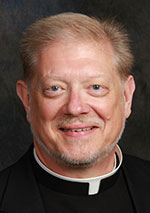That All May Be One / Fr. Rick Ginther
A pope’s message for the unity of faith still resonates
 As I write this on November 10, the Church is celebrating the memorial of Pope Saint Leo the Great.
As I write this on November 10, the Church is celebrating the memorial of Pope Saint Leo the Great.
This 5th century bishop of Rome (440-461AD) was a towering figure.
He was a key figure in the 4th Ecumenical Council, Chalcedon. This council confirmed the two natures of Christ, human and divine, in one person.
It was Pope Leo who asserted the universal jurisdiction—Petrine supremacy—of the Roman bishop.
He defended Rome against the Huns, facing down Attila outside of Rome.
He was declared a Doctor of the Church and is only one of two popes so named.
The Eastern Catholic Churches and Eastern Orthodox Churches honor him in their liturgical calendars.
What does such a pedigree have to do with ecumenism?
Well, the Office of Readings for this day offers an excerpt from a sermon Pope Leo preached on the anniversary of his installation as Bishop of Rome.
Its content is stunning in its theology of the individual Christian.
“Although the universal Church of God is constituted of distinct orders of members, still, in spite of the many parts of its holy body, the Church subsists as an integral whole, just as the Apostle says: We are all one in Christ. No difference in office is so great that anyone can be separated, through lowliness, from the head. In the unity of faith and baptism, therefore, our community is undivided.”
The common dignity shared by all the baptized is then supported through quotes from the apostle Peter. “And you are built up as living stones into spiritual houses, a holy priesthood, offering spiritual sacrifices which are acceptable to God through Jesus Christ. And again: But you are a chosen people, a royal priesthood, a holy nation, a people or election.
“For all, regenerated in Christ, are made kings by the sign of the cross; they are consecrated priests by the oil of the Holy Spirit, so that beyond the special service of our ministry as priests, all spiritual and mature Christians know that they are a royal race and are sharers in the office of the priesthood.” (Sermo 4, 1-2; PL 54, 148-149)
Fifteen hundred years later, the Second Ecumenical Vatican Council promulgated Lumen Gentium (LG), the Dogmatic Constitution on the Church (November 21, 1964).
In paragraph 10, it notes: “Christ the Lord, High Priest taken from among men, made the new people ‘a kingdom and priests to God the Father’. The baptized, by regeneration and the anointing of the Holy Spirit, are consecrated as a spiritual house and a holy priesthood …”
“Though they differ from one another in essence and not only in degree, the common priesthood of the faithful and the ministerial or hierarchical priesthood are nonetheless interrelated: each of them in its own special way is a participation in the one priesthood of Christ.”
There is a poignant irony here. The Reformers of the 16th century insisted on the priesthood of the people, at times to the diminishment of the ministerial priesthood. Sadly, this was a reaction to the centuries’ old diminishment within the Church of the priesthood of the faithful!
By the 20th century, a growing sense of the “both/and” of Pope Leo had re-emerged. An ecumenical impetus was born.
The dignity of all Christians baptized into Christ Jesus impels us to relationships with other Christians.
It impels us to be thankful for this shared dignity and calling during the approaching holiday.
It impels us to pray earnestly “that all may be one.”
(Father Rick Ginther is director of the archdiocesan Office of Ecumenism and Interreligious Affairs. He is also the pastor of Our Lady of Lourdes Parish, Indianapolis.) †
 As I write this on November 10, the Church is celebrating the memorial of Pope Saint Leo the Great.
As I write this on November 10, the Church is celebrating the memorial of Pope Saint Leo the Great.